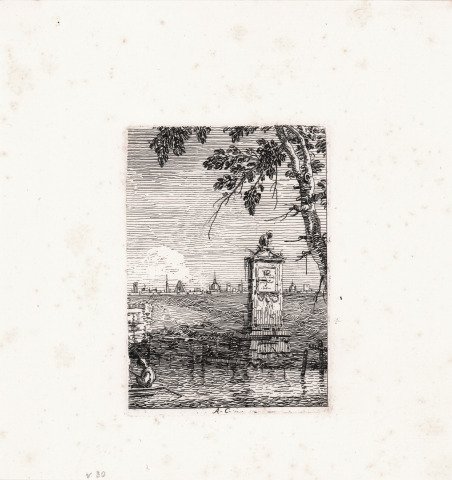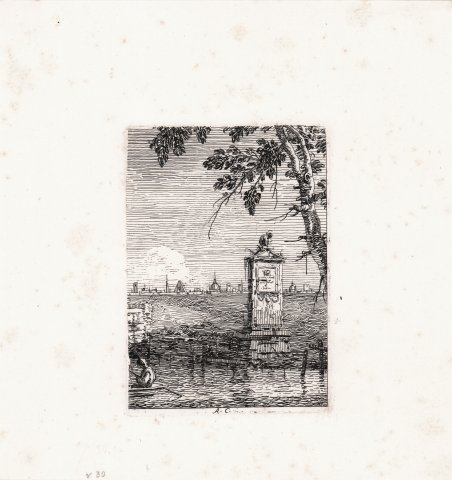Acquaforte, 1740 ' circa, monogrammato in lastra in basso al centro A.C. Esemplare nel secondo stato finale, dopo le aggiunte e con la sigla in basso al centro. Della serie ' Vedute altre prese da i Luoghi altri ideate. In basso a sinistra in primo piano, la continuazione della barca e del ponte parzialmente visti nell'acquaforte Il carro che passa sopra un ponte. Sulla riva lontana del fiume il monumento, incorniciato da un albero e dal fogliame. In lontananza, oltre una zona collinare, vista di una città con torri, campanile, cupole e una piramide. Originariamente questa stampa e Il carro che passa sopra un ponte formavano una lastra unica che venne tagliata forse per un difetto di morsura verificatosi nella zona dell’albero sovrastante il piccolo monumento. Per tale ragione la parte destra della lastra subì una riduzione di circa 25 mm in altezza. Non si conoscono impressioni prima del taglio del rame che venne operato dallo stesso artista, come dimostra l’apposizione – nel secondo stato – della sigla A.C. sul margine inferiore della lastrina con Il Piccolo Monumento. L’elemento decorativo posto alla sommità dell’edificio, forse un leone, è assai prossimo alla scultura, pure enigmatica, che compare sulla colonna ionica del dipinto Capriccio con tempio e colonna. L’opera appartiene alle Vedute altre prese da i luoghi altre ideate… serie delle acqueforti dedicate al console ed amico Joseph Smith, la cui esecuzione va dal 1740 al 1744 circa. Si inserisce nello sviluppo artistico del Canaletto non come parentesi marginale, ma come un momento essenziale di alcuni problemi stilistici, che troveranno la loro piena realizzazione nei primi capolavori eseguiti nel soggiorno inglese. ' La serie raggruppa fogli che evocano un itinerario che partendo dalla laguna, cioè da Marghera, passando per Mestre, risale il corso del Brenta fino a Padova, non solo inscenata nel cosmorama del Prà della Valle ma in una veduta che segna il passaggio tra la realtà dei luoghi e la fantasia del capriccio. Se il Portico con la lanterna, indubbiamente una delle prove più alte dell’arte incisoria del Canaletto, è una veduta di piena fantasia, l’acquaforte con la cosiddetta Casa del 1741, ricongiunta con la Casa del colonnato, è l’evocazione di una città, che se pur manca di precisi riferimenti topografici, è intrisa di atmosfera veneziana. ' Giovanni Antonio Canal detto Canaletto (Venezia 17 ottobre 1697 – Venezia 19 aprile 1768) fu il più illustre protagonista del vedutismo veneziano del Settecento. Grazie a contatti con amatori e collezionisti inglesi in viaggio a Venezia o residenti nella città lagunare, Canaletto beneficia di grande notorietà in Inghilterra presso la più alta aristocrazia e perfino la famiglia reale. Attorno al 1730 suo agente esclusivo è un inglese, il console Joseph Smith: divenuto mercante di quadri, questi si adopera con abilità e tenacia per introdurre il suo protetto nel mercato britannico delle opere d’arte, il più florido al tempo. Titolare di una grande bottega e affiancato da innumerevoli assistenti, Canaletto è artista e abile imprenditore. ' Nelle opere del Canaletto la città lagunare era raffigurata con grande oggettività: le sue composizioni erano sempre rigorosamente studiate attraverso numerosi disegni preparatori, tratti direttamente dal vero. La “veduta” fu uno dei generi più caratteristici della pittura del Settecento. Si differenzia dal paesaggio (altro genere molto diffuso nel XVIII secolo) per la rappresentazione oggettiva di luoghi e architetture, realizzata attraverso una prospettiva ben studiata. Venezia fu il centro di maggior produzione di “vedute”, con alcune personalità di grande spicco. Al verso, timbro di collezione di James Henry Lockhart (Pittsburgh 1912-Rotonda West 2002) - ' Lugt 4387. Magnifica prova, impressa su carta vergata coeva, con margini, in ottimo stato di conservazione. Bibliografia Bromberg, n. 33 p. 169; Succi, I, p. Etching, 1740 circa, signed with monogram bottom centre: A. C. Second final state, with the signature added and other additions. From the series: Vedute alter prese da i Luoghi altri ideate - In the lower left foreground, the continuation of the boat and bridge partially seen on the etching The Waggon Passing over a Bridge. On the far bank of the river the monument, framed by a tree and foliage. In the distance beyond a hilly area, view of a town with towers, campanile, domes and a pyramid. Originally this print and The Waggon Passing over a Bridge formed a single plate that was cut perhaps because of a morsure defect occurred in the area of the tree above the small monument. For this reason, the right side of the plate was reduced in height by about 25 mm. There are no known impressions before the cutting of the copper, which was done by the artist himself, as shown by the affixing - in the second state - of the initials A.C. on the lower margin of the plate with The Little Monument. The work belongs to the Vedute altre prese da i luoghi altre ideate. series of etchings dedicated to the consul and friend Joseph Smith, whose execution goes from about 1740 to 1744. It is part of the artistic development of Canaletto not as a marginal parenthesis, but as an essential moment of some stylistic problems, which will find their full realization in the first masterpieces executed in his English stay. ' The series groups together sheets that evoke an itinerary that starting from the lagoon, that is from Marghera, passing through Mestre, goes up the course of the Brenta to Padua, not only staged in the cosmorama of Prà della Valle but in a view that marks the passage between the reality of places and the fantasy of caprice. If the Portico with the lantern, undoubtedly one of the highest proofs of Canaletto's engraving art, is a view of full fantasy, the etching with the so-called House of 1741, rejoined with the House of the colonnade, is the evocation of a city, which even though it lacks precise topographical references, is imbued with Venetian atmosphere. ' Giovanni Antonio Canal called Canaletto (Venice 17 October 1697 - Venice 19 April 1768) was the most illustrious protagonist of the Venetian vedutismo of the eighteenth century. Thanks to his contacts with English amateurs and collectors travelling to Venice or living in the lagoon city, Canaletto enjoyed great notoriety in England among the highest aristocracy and even the royal family. Around 1730 his exclusive agent was an Englishman, the consul Joseph Smith: having become a picture dealer, he worked with skill and tenacity to introduce his protégé into the British market of works of art, the most flourishing at the time. Owner of a large workshop and flanked by countless assistants, Canaletto is an artist and a skilled entrepreneur. ' In Canaletto's works the lagoon city was depicted with great objectivity: his compositions were always rigorously studied through numerous preparatory drawings, taken directly from life. The "veduta" was one of the most characteristic genres of eighteenth-century painting. It differs from landscape (another genre widespread in the eighteenth century) for the objective representation of places and architecture, achieved through a well-studied perspective. Venice was the center of greater production of "views", with some very important personalities. On verso, collection mark of James Henry Lockhart (Pittsburgh 1912-Rotonda West 2002)- ' Lugt 4387. A fine impression, printed on contemporary laid paper, good condition. ' Bibliografia Bromberg, n. 33 p. 169; Succi, I, p. 278, n. 7. Cfr.


Find out how to use
Find out how to use

